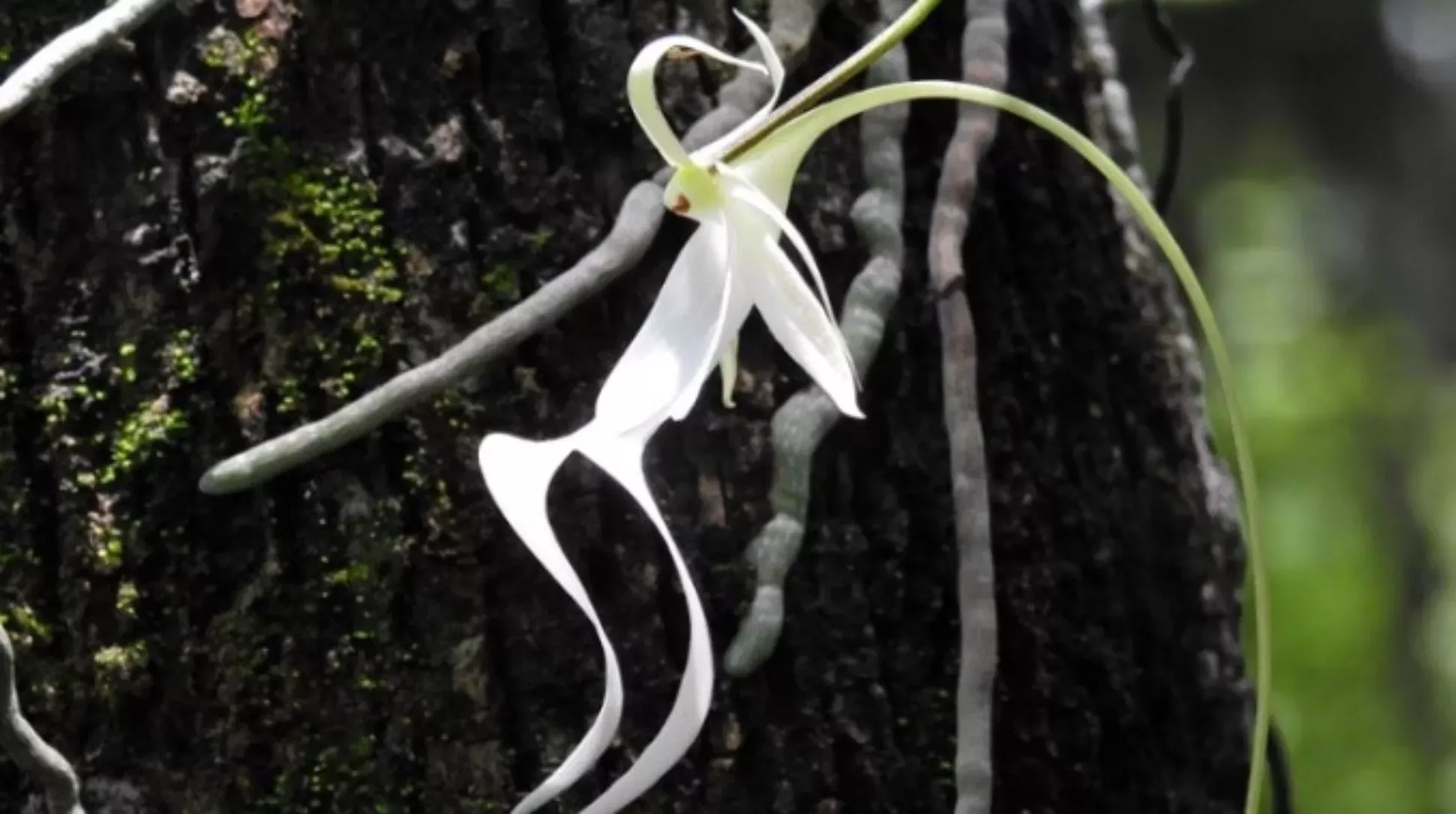Rare Florida Ghost Orchid flowers in UK for first time at Kew Gardens
Release date: 1 June 2023

The rare and endangered Ghost Orchid has flowered in UK for first time at Kew Gardens.
The orchid bud has been on show at an Orchid Conservation Display created by a collaboration between J.P. Wright Company of Florida and Grow Tropicals UK, as well as the Royal Botanic Gardens, Kew and other organisations. Following its time at Chelsea, the orchid has been rehomed at Kew Gardens in London, where it is on display to the public in the Princess of Wales Conservatory.
Dendrophylax lindenii is commonly known in America as the ghost orchid, and is surrounded by an air of mystery and intrigue. These leafless orchids bloom in the dark and shadows in Cuba and South Florida; the flowers possess a beautiful fragrance which is only released at night. Dendrophylax means ‘tree guardian’, and the roots wrap themselves protectively around the trunk of their host tree. Ghost orchid populations in Florida were decimated when their host trees, majestic 1,000-year-old
Taxodium distichum (bald cypress), were logged in World War II to provide lumber for aircraft carrier decks in the Pacific. Only around 1,500 Dendrophylax lindenii plants remain in South Florida and fewer than 500 are found in Cuba. The species is recorded as Endangered on IUCN Red List of Threatened Species.
Habitat destruction is one of the leading causes for the decline of ghost orchid populations globally, and this display at Kew Gardens therefore aims to highlight the critical role which orchids play in ecosystems globally and the pressing need to conserve them. Drawing on expertise from RBG Kew and partner organisations*, visitors to the Princess of Wales Conservatory can learn more about recent efforts to find and protect the rare Florida Ghost Orchid, along with rare and endangered orchids which make up Kew’s living collection.
RBG Kew and Orchids
Dating back to at least 1787, RBG Kew has one of the oldest collections of living tropical orchids in the world, as well as the largest Orchid Herbarium, which holds over 400,000 preserved specimens. Today, RBG Kew’s living orchid collection contains around 8,000 plants, representing approximately 1,300 species. With some species now thought to be extinct in the wild, RBG Kew’s collection of living and preserved orchids is an invaluable resource for the scientific community, but the care of the collection falls to Kew’s team of skilled horticulturists, demonstrating the interconnection between horticulture and science. As one of the most biodiverse places in the world, RBG Kew is uniquely positioned as a centre of excellence in the application of scientific knowledge about plants, and it is this relationship that underpins Kew’s core purpose.
Why Orchids matter to the environment
Orchids are considered the canary in the coal mine for extinction, as they are extremely sensitive to changes in the environment and their disappearance from an area is often seen as an indicator of poor ecosystem health. Each year, Kew Gardens celebrates this important species with its famous Orchid Festival, in which the Princess of Wales Conservatory is adorned with over 5000 orchids displayed in innovative designs and sculptures. This year’s display was inspired by the beauty and biodiversity of Cameroon, a country that is home to 450 species of orchid – some so rare their locations must be kept secret for their own protection.
ABOUT ROYAL BOTANIC GARDENS, KEW
The Royal Botanic Gardens, Kew is a world-famous scientific organisation and conservation charity, internationally respected for its outstanding collections and scientific expertise in plant and fungal diversity, conservation, and sustainable development in the UK and around the globe. Kew’s scientists and partners lead the way in the fight against biodiversity loss and finding nature-based solutions to the climate crisis, aided by five key scientific priorities outlined in Kew’s Science Strategy 2021-2025. Kew Gardens is also a major international and top London visitor attraction. Kew’s 132 hectares of historic, landscaped gardens, and Wakehurst, Kew’s Wild Botanic Garden and ‘living laboratory’, attract over 2.5 million visits every year. Kew Gardens was made a UNESCO World Heritage Site in July 2003 and celebrated its 260th anniversary in 2019. Wakehurst is home to the Millennium Seed Bank, the largest wild plant seed bank in the world and a safeguard against the disastrous effects of climate change and biodiversity loss. RBG Kew received approximately one third of its funding from Government through the Department for the Environment, Food and Rural Affairs (Defra) and research councils. Further funding needs to support RBG Kew’s vital scientific and educational work comes from donors, memberships and commercial activity including ticket sales.
For tickets, please visit www.kew.org/kew-gardens/visit-kew-gardens/tickets. In the first six months since implementing a new accessibility scheme for those in receipt of Universal Credit, Pension Credit and Legacy Benefits, Kew has welcomed over 20,000 visitors with £1 tickets.
*The team includes world experts from Glasgow Botanic Gardens, Naples Botanical Garden, Chicago Botanic Garden, Fairchild Tropical Botanic Garden, Illinois College, Stetson University, University of Florida, Smithsonian’s North American Orchid Conservation Center (NAOCC) and Smithsonian Gardens.